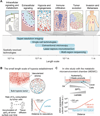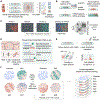The Spatial and Genomic Hierarchy of Tumor Ecosystems Revealed by Single-Cell Technologies
- PMID: 31311656
- PMCID: PMC6689240
- DOI: 10.1016/j.trecan.2019.05.009
The Spatial and Genomic Hierarchy of Tumor Ecosystems Revealed by Single-Cell Technologies
Abstract
Many malignancies display heterogeneous features that support cancer progression. Emerging high-resolution methods provide a view of heterogeneity that recognizes the influence of diverse cell types and cell states of the tumor microenvironment. Here we outline a hierarchical organization of tumor heterogeneity from a genomic perspective, summarize the origins of spatially patterned metabolic features, and review recent developments in single-cell and spatially resolved techniques for genome-wide study of multicellular tissues. We also discuss how integrating these approaches can yield new insights into human cancer and emerging immune therapies. Applying these technologies for the analysis of primary tumors, patient-derived xenografts, and in vitro systems holds great promise for understanding the hierarchical structure and environmental influences that underlie tumor ecosystems.
Keywords: epigenetics; genomics; hypoxia; in situ; metabolism; stroma.
Copyright © 2019 Elsevier Inc. All rights reserved.
Conflict of interest statement
Competing interests
The authors declare no competing financial interests.
Figures




References
Publication types
MeSH terms
Substances
Grants and funding
LinkOut - more resources
Full Text Sources

